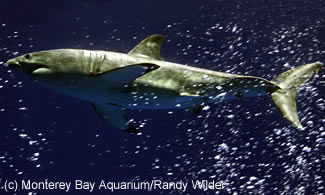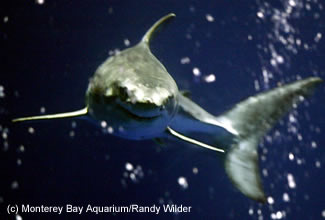
File photo of the second great white shark put on exhibit at the Monterey Bay Aquarium

File photo.
The electronic tag recovered from a young white shark released in January by the Monterey Bay Aquarium recorded his travels on a 90-day trip to the southern tip of Baja California – a journey covering more than 2,200 miles (3,500 km) that took him up to 700 miles (1,100 km) offshore and to depths more than 1,000 feet (300 m) below the surface, researchers with the aquarium and Stanford University reported today.
Scientists are adding the data to information gathered from other tracking tags on juvenile white sharks to build a more detailed picture of where young white sharks in Southern California waters are traveling and what they're doing in the wild.
"It clearly shows that like many migratory animals, sharks don't recognize international boundaries," said Dr. Salvador Jorgensen, a postdoctoral researcher with the aquarium and the Tagging of Pacific Predators team at Stanford University's Hopkins Marine Station. "It underscores how important it is to work closely with our Mexican colleagues to make sure we have adequate protection for the species."
The electronic tag, recovered on April 23 about 77 nautical miles west of Mazatlán, Mexico, recorded the white shark's movements for 90 days, from the time it was released on January 16 near Point Pinos at the southern tip of Monterey Bay until the tag popped free 25 nautical miles off the southern tip of Baja California, near Cabo San Lucas
The young shark spent 137 days at the aquarium prior to his release. During that time he grew from a length of 5-foot-8 (1.7 m) and 103 pounds (49 kg) when he arrived on August 31, 2006 to a size of 6-foot-5 (2.0 m) and 171 pounds (78 kg). The shark was healthy and feeding at the time of release, but had grown large enough that to delay his release much longer could have posed logistical challenges, and potentially risks to human safety, during the return from the exhibit to the wild, said Randy Hamilton vice president of husbandry for the aquarium.
On April 15, the tag released on schedule and began transmitting data via satellite to scientists at the Tuna Research and Conservation Center (TRCC), a collaboration between Stanford and the aquarium. The tag was subsequently radio-tracked and netted out of the water off Mazatlán by Senior Aquarist Scott Reid and an international team from the aquarium, Stanford and Mexico that was hosted by Fernando Marquez of Mexico's Instituto Nacional de Pesca (National Fisheries Institute).
Stanford researchers spent the last month analyzing and mapping data from the tag – data that were recorded every 10 seconds while the tag was on the shark. They learned that he swam more than 300 miles (480 kilometers) offshore and was at times diving more than 1,000 feet (around 300 meters) deep.
"It looks like the shark spent his days near the surface, with occasional deep dives to around 660 feet (200 meters) – a pattern typical of adults when they are traveling to and from the California coast to offshore hotspots between California and Hawaii," said Dr. Kevin Weng, a white shark researcher affiliated with Dr. Barbara Block's lab at Hopkins Marine Station.
At night, the shark avoided surface waters and swam in an oscillatory manner with an average depth near 250 feet (75 meters). He made his deepest dives at dawn and dusk, Weng said.
After the shark's release in waters around 50 degrees F, he quickly moved offshore to warmer water, in the 60 degree F range. As the shark headed south, he spent time in waters as warm as 75 degrees F before returning to slightly cooler temperatures, around 70 degrees F, Weng said.
The white shark's last known position – just before the tag popped off – was at an important seamount at the entrance of the Sea of Cortez, the Cabrillo Seamount, known in Mexico as "Bajo Cabrilla."
Seamounts – underwater mountains that don't break the surface as islands do – are important habitat and foraging grounds for many open ocean animals, Jorgensen said.
"The tag popped up at the entrance to the Sea of Cortez, at the southern end of the known range for juvenile white sharks," he said. "Juvenile and adult white sharks have been captured inside the Sea of Cortez but we don't know whether they are born there or migrate in and out. So it's very interesting to see this juvenile show up right at the entrance."
"It is only with international collaboration that we can begin to understand the connections between white sharks inhabiting U.S. waters off California, and Mexican waters at Guadalupe Island and in the Gulf of California," Marquez said. "The Instituto Nacional de la Pesca and World Wildlife Fund have been tagging large pelagic fishes in the Gulf of California, and Mexican scientists will soon be meeting with colleagues in Monterey to discuss the best approaches for analyzing data from tags deployed on large sharks."
The aquarium will begin its fifth field season of white shark research later this month, and will attempt to bring another young shark back to Monterey for exhibit. In addition to the husbandry effort, key areas of study with its research partners at Stanford and California State University-Long Beach will involve continued tagging of juvenile and adult white sharks to learn where and when they move in California waters, and DNA sampling to learn more about the population of white sharks in the region.
Weng and the TRCC team have analyzed data returned from seven tags placed on young white sharks since the field project began in 2002 – not including the two animals tagged at release from the aquarium. They have submitted their findings for publication in the scientific press.
Through its Center for the Future of the Oceans, the aquarium is working with other institutions and agencies to help develop strategies for white shark conservation policy in California and Mexican waters, said Dr. Chris Harrold, director of conservation research for the aquarium.
Data from white sharks tagged in the field will be shared with wildlife officials who can use the information to inform fisheries management decisions involving young white sharks, he said.
The shark was caught by aquarium collectors offshore in Santa Monica Bay on August 17, 2006. He spent two weeks in a 4-million-gallon ocean pen off Malibu and was observed feeding in the pen before he was brought to Monterey on August 31.
During his stay, more than 600,000 visitors saw the white shark and learned more about shark conservation issues in conversations with staff and volunteer guides; through a question-and-answer auditorium program devoted to the white shark project; in other exhibits that address shark conservation; and through exhibit graphics specifically addressing the threats facing white sharks.
"He was an incredible ambassador for white sharks and shark conservation," Hamilton said.
Since 2002, the nonprofit aquarium has contributed more than $1 million to a number of white shark field research projects.
Details about the white shark research project are online at www.montereybayaquarium.org. Information about the recovery of the tag can also be found online at http://ontoppoftheworld.blogspot.com/2007/05/juvenile-white-shark-records.html
